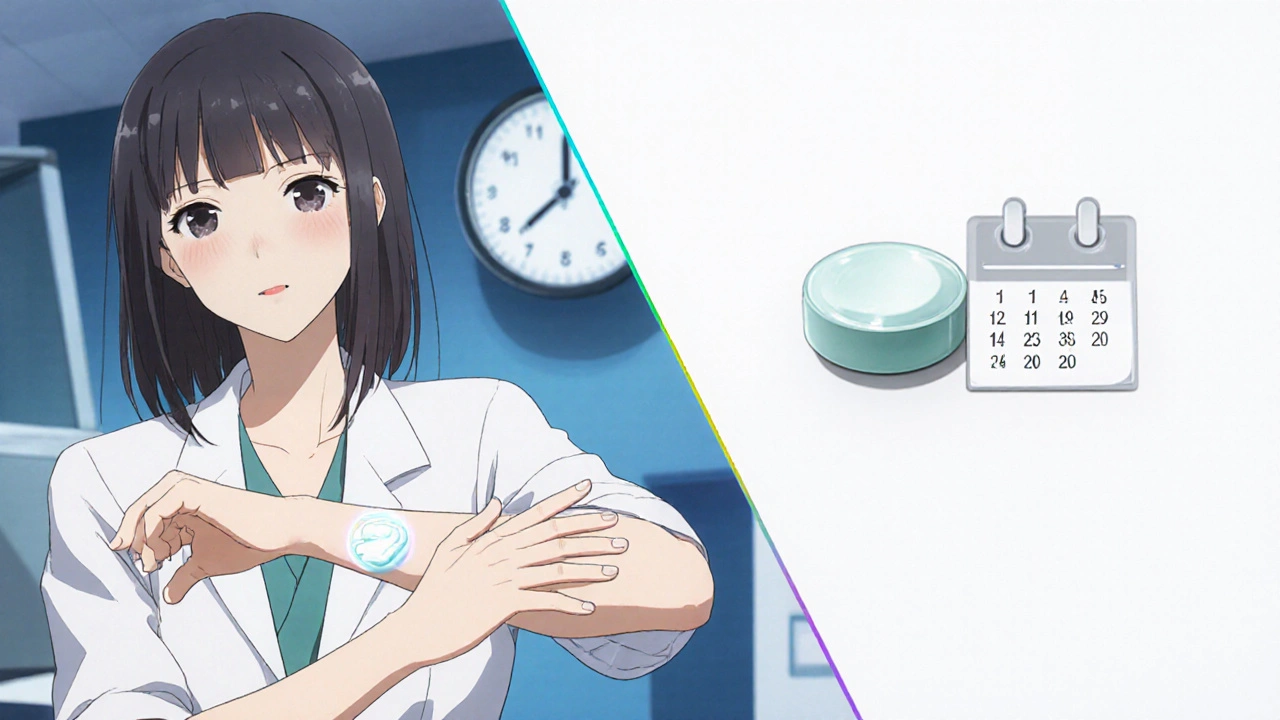Tinea Versicolor Treatment Selector
Treatment Recommendation Tool
Answer the following questions to determine the most appropriate treatment for your tinea versicolor.
When those patchy, discolored spots appear on the shoulders, chest or back, many people assume it’s just a harmless rash. In reality, the condition tinea versicolor treatment often requires targeted antifungal therapy to clear the infection and prevent recurrence. Below we break down how well the most common antifungal medications work, when to choose a cream versus a pill, and practical tips to get the best results.
What Is Tinea Versicolor?
Tinea Versicolor is a superficial fungal infection of the skin caused by an overgrowth of the yeast Malassezia. The yeast lives harmlessly on most adults, but when the skin’s oil balance shifts-often after hot weather, excessive sweating, or hormonal changes-it multiplies and disrupts melanin production, creating the characteristic light‑ or dark‑colored patches.
How Antifungal Medications Fight the Yeast
Antifungal drugs target the cell membrane of Malassezia, disrupting its ability to synthesize ergosterol, a key component that keeps the fungal cell intact. Without ergosterol, the yeast cell leaks and eventually dies, letting the skin return to its normal color. Both topical and oral formulations act on this pathway, but they differ in how deep they penetrate and how quickly they work.
Topical Antifungal Options
For most mild‑to‑moderate cases, a cream, lotion or shampoo applied directly to the affected skin does the trick. Below are the three most frequently prescribed topical agents, along with their typical use patterns and reported success rates.
- Ketoconazole 2% cream or shampoo - Apply twice daily for 2‑4 weeks. Clinical studies show a 70‑85% clearance rate after a full course.
- Clotrimazole 1% cream - Use once or twice daily for 2‑3 weeks. Real‑world data suggest about 65% of patients experience complete resolution.
- Selenium sulfide 2.5% shampoo - Leave on scalp and affected skin for 5‑10 minutes, then rinse; repeat 2‑3 times weekly for 4 weeks. Success rates hover around 60% when combined with a cream.
Topicals are generally safe, but irritation, itching, or a mild burning sensation can occur, especially on broken skin. If the rash is widespread or recurs quickly after stopping the cream, an oral option may be warranted.

Oral Antifungal Options
Systemic medication is reserved for extensive disease, frequent relapses, or when the infection involves areas that are hard to treat topically (e.g., scalp). The two most common oral agents are:
- Fluconazole 150 mg once weekly for 2‑4 weeks - Provides an 85‑95% cure rate in clinical trials, with the convenience of a single weekly dose.
- Itraconazole 200 mg daily for 1 week (pulse therapy) - Shows a similar efficacy to fluconazole but may cause liver enzyme elevation in a small percentage of patients.
Oral drugs carry a higher risk of systemic side effects such as nausea, headache, and rare liver toxicity, so baseline liver function tests are recommended before starting therapy.
Comparison: Topical vs. Oral Antifungals
| Medication | Form | Typical Dose | Treatment Duration | Success Rate | Common Side Effects |
|---|---|---|---|---|---|
| Ketoconazole | Cream / Shampoo | 2% applied BID | 2‑4 weeks | 70‑85% | Local irritation, mild burning |
| Clotrimazole | Cream | 1% applied QD‑BID | 2‑3 weeks | ~65% | Pruritus, redness |
| Selenium sulfide | Shampoo | 2.5% leave‑on 5‑10 min | 3‑4 weeks (2‑3×/wk) | ~60% | Dry scalp, odor |
| Fluconazole | Tablet | 150 mg weekly | 2‑4 weeks | 85‑95% | Nausea, headache, rare liver impact |
| Itraconazole | Capsule | 200 mg daily (7 days) | 1 week (pulse) | 80‑90% | GI upset, liver enzyme rise |
Choosing the Right Treatment for You
Not every case needs a pill. Consider these factors before deciding:
- Extent of the rash: If the patches cover less than 15% of body surface, a topical is usually sufficient.
- Location: Scalp or beard areas may respond better to oral drugs or medicated shampoos.
- Age & Pregnancy: Pregnant women should avoid oral azoles; topical ketoconazole 2% is considered safer.
- History of recurrence: Frequent flare‑ups (more than three per year) suggest a maintenance plan with periodic selenium sulfide washes.
- Medical comorbidities: Liver disease or concurrent medications that interact with azoles make oral therapy riskier.
When in doubt, a short course of a topical agent followed by a reassessment after two weeks is a low‑risk way to gauge response.

Practical Tips for Using Antifungal Medications
- Clean the area first: Wash with a mild cleanser, pat dry, then apply the cream. Moisture helps the drug penetrate.
- Follow the full course: Even if spots fade after a few days, continue the regimen to eradicate the yeast fully.
- Track progress with photos: A side‑by‑side comparison after one, two, and four weeks helps you see subtle changes.
- Avoid occlusive dressings: Covering the treated skin can trap heat and worsen the infection.
- Watch for side effects: If you develop severe itching, swelling, or signs of liver trouble (yellowing skin, dark urine), stop the medication and contact a dermatologist.
Prevention and Long‑Term Maintenance
The best cure is none at all. Here are proven strategies to keep Malassezia in check:
- Use a Selenium sulfide shampoo once a week during humid months.
- Wear breathable fabrics; avoid tight synthetic clothing that traps sweat.
- Limit oily skin products, as excess lipids feed the yeast.
- Consider a brief Wood's lamp exam with a dermatologist every 6‑12 months if you’ve had multiple recurrences.
- Maintain good hygiene after sports or heavy work-shower promptly and dry skin thoroughly.
Mini FAQ
Can I use over‑the‑counter antifungal creams for tinea versicolor?
Yes, many OTC products contain clotrimazole or miconazole and work for mild cases. However, prescription‑strength ketoconazole often clears the infection faster and with higher success.
Why does the rash reappear after I finish treatment?
The yeast lives on the skin as a normal resident. If the underlying triggers-heat, humidity, oily skin-remain, the organism can multiply again. A maintenance shampoo or periodic topical spray helps prevent relapse.
Is tinea versicolor contagious?
No, it isn’t spread through skin‑to‑skin contact. It’s an overgrowth of a yeast that already lives on each person’s skin.
Can I use antifungal shampoo on my scalp to treat the infection on my back?
Applying the shampoo to both the scalp and the affected back area can be effective, especially if you notice dandruff‑like scaling on the shoulders. Let the lather sit for a few minutes before rinsing.
Are there any natural remedies that work?
Tea tree oil and apple cider vinegar have mild antifungal properties, but clinical evidence is limited. They may help as adjuncts but shouldn’t replace proven medications for moderate‑to‑severe cases.
Understanding how each antifungal works and matching it to the severity of your tinea versicolor can shave weeks off recovery and cut down on frustrating recurrences. Talk to a dermatologist if you’re unsure which option fits your lifestyle, and don’t forget the preventive steps-your skin will thank you.






Honestly, the elegance of ketoconazole’s mode of action feels like a microscopic sonnet. 😏